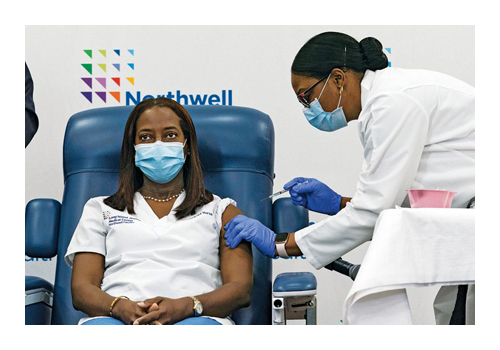
Among the first vaccinations in the nation in December, Michelle Lester (right) vaccinates Sandra Lindsay, a nurse at Long Island Jewish Medical Center, with the Pfizer vaccine.
Related
Life Expectancy in the U.S. from 2019 CDC National Vital Statistics Reports
- 84.3 years Hispanic Female
- 81.2 years Non-Hispanic White Female
- 79.1 years Hispanic Male
- 78.5 years Non-Hispanic Black Female
- 76.4 years Non-Hispanic White Male
- 71.9 years Non-Hispanic Black Male
Demand for COVID-19 vaccine grows, while infections slow
Contributed By:The 411 News
Hesitancy to take the vaccine and life span are factors in low numbers of blacks vaccinated
Gary's Health Commissioner, Dr. Roland Walker is happy that Lake County's coronavirus infection numbers are decreasing. "But really important is that we continue to mask and social distance until we get more people vaccinated. The longer we take to get to herd immunity, the greater chance that the virus mutates to a variant that we can't control. I pray people are not getting over confident."
Lake County reported a total of 92 new infections on January 30, the first daily case count under 100 since October 7, 2020. The county saw a high of 719 new cases on November 13.
For 2 days, February 1-2, only 55 new cases were reported each day; but the next day, February 3, the county reported 140 new cases.
Indiana Governor Eric Holcomb and Indiana's Health Commissioner, Dr. Kristina Box announced plans to get more Hoosiers vaccinated at their recent COVID-19 update. This week, Hoosiers 65 and up became eligible to register to receive their first shot of the COVID-19 vaccine.
Dr. Box explained why the number of Blacks vaccinated in Indiana is low, even though they are at the highest risk of infections and deaths from the disease. Along with some African Americans being hesitant about taking the vaccine, Dr. Box said life span is also a factor.
Indiana's first vaccinations in December went to health care workers and residents in long-term health care facilities. Next vaccinated were first responders – public safety personnel. Indiana is now using age as the criteria for eligibility. Those 80 and older were eligible to register the first week in January. Residents age 70 and over followed.
"We knew there would be fewer African Americans in their 80s. Because of diabetes, hypertension, and heart disease, not many African Americans are alive in their 80s," Dr. Box said. "We hope with education – messaging showing more individuals are getting vaccinated – we'll see an uptick in these populations and we will be catching up to them in lower age groups."
Hundreds of thousands of Indiana residents have registered to receive the vaccine, but supply is the problem. Dr. Box said the state is now receiving 100,000 doses a week. "We could vaccinate all who have registered if we had the doses."
Since the Pfizer and Moderna vaccines require 2 shots, 21 and 28 days apart, state health departments have to determine when and how fast to expand the eligibility list based on the number of doses they receive each week.
Indiana's age-based eligibility satisfies medical ethics, Dr. Box said, by vaccinating the most vulnerable populations, those most likely to be hospitalized and die if they contract the virus.
"When we look at individual comorbidities, what are the highest risks? It was clear from the data, from the evidence, from the research, it was age,” said Dr. Box. “That is why we started with age and Indiana’s data has backed that up.”
Dr. Box said they will now look to add people with underlying health conditions but did not give an exact time frame on when that would happen.
The Centers for Disease Control and Prevention's COVID Data Tracker shows Indiana has received a combined total of 1,117,350 doses. The state has administered 710,888 doses, with 568,118 receiving 1 or more doses. The number of Hoosiers who have received the second dose is 142,405.
Story Posted:02/06/2021
|